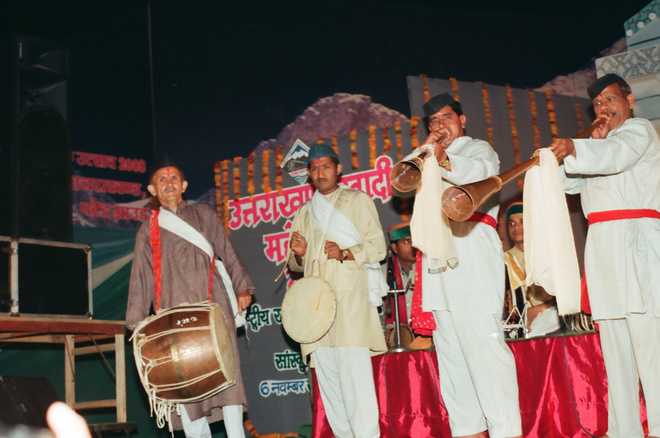Dhol, damaou integral to hill ceremonies
Neena Sharma
Tribune News Service
Dehradun, December 17
No religious ritual or auspicious work is complete without the sound of dhol. In the days gone by, dhol and damaou were also used for communication or sending messages between villages. Dhol and damaou are played according to the rules mentioned in Dhol Sagar, an oral treatise passed on from generation to generation of the Oji tribe of Uttarakhand. Dhol Sagar gives the details of 36 types of musical instruments. It also has a spiritual connect and contains a discourse between Lord Shiva and Goddess Parvati about the origin of the galaxy.
No wonder then these musical instruments are an intrinsic part of one’s life in Uttarakhand. It is the dhol and damaou players who are summoned during the first ‘sanskar’ of a child in Uttarakhand and again on one’s death.
Dhol and damaou are played along with dancing during festivals round the year. For the past several years, ‘Dhol Vadan’ continues to be the preserve of Ojis, who have kept the tradition alive and continue to be devoted to their craft.
In the central Himalayan region of Garhwal, it is believed that gods (devtas) enjoy dancing. Musicians whether ritual specialists or music specialists are, therefore, indispensable for most of the entertainment and religious events. “In shamanistic ceremonies, their incantations, songs and drumming ‘make’ gods possess their mediums. In other context, during a dramatic and theatrical rendition of stories of specific deities, actors ‘dance’ the role of their character having become possessed by his or her (deity’s) spirit. “Through the powerful sounds of drumming, musicians cause gods to dance,” says Andrew Alter, musicologist.
Alter says the way the dhol is played in Uttarakhand has a strong link to the geography. During wedding ceremonies in the Garhwal Himalayas, the performance of traditional drummers accompanying the wedding procession changes according to their geographical positioning at a given time. If the wedding procession is passing through low-lying valleys, the collection of music played will be different than when it reaches a high ridge or the bend at the top of the mountain.
Legendary dholis
Dholi Shetal Das, who hails from Deval (Chamoli), was an expert drum player and was known to even cause a fruit-laden tree drop fruits on the ground by the sheer power of his drumming.
Another traditional musical instrument artiste Moulu Das died in penury two years ago. He had the distinction of playing naubat for 18 years.
However, now brass band is being promoted in the hills in the weddings. As a result, there is no new generation of dholis. Moreover, the condition of the families of artistes has filled them with an inferiority complex. They do not see it as a means of living.
Present-day drummers
As brass band is being promoted in the hills and a few religious ceremonies are being followed in the hills, there are very few dholis left to carryg forward this age-old profession. The government’s apathy and social neglect have given them a sense of inferiority complex. The present generation is not keen to follow in the footsteps of their forefathers and keep the profession alive. So much so, there are very few masters left who can recite the Dhol Sagar treatise.
Masters of Dhol Sagar
Dholi Sumangal Das from Danda Nagar Ja in Pauri Garhwal district leaves his audience spellbound with his recitation of Dhol Sagar and spontaneous beating of the drum. Similarly, Omkar Das and Shivjani are above 70 years and are among the last masters of Dhol Sagar in Tehri Garhwal district. There is no one to take forward the tradition after them.
Among the younger generation, Sohanlal, brother of Sukaru Das, is known to be a master of Dhol Sagar. He had even performed in the USA. He is the torchbearer of this more than 100-year-old folk tradition of Garhwal and Kumaon. Uttam Das, a resident of Savli village in Tehri Garhwal district, is in his fifties and perhaps the only artiste who is an expert in playing ragas on both dhol and damaou. “What can I say? I owe it all to the blessings of Chanderbadni Maa. This feat is a rare accomplishment and unless an artiste puts his heart and spirit into learning the craft, the technique will always elude him,” says Uttam.
Sohanlal has seen many ups and downs in his life since he started playing dhol but he has never wavered from the tradition. He is worried about the survival of the craft in future.
Though people in Uttarakhand and those who have settled in other parts of the country still encourage this art form and invite artistes, but people of my community generally look down upon dhol playing. It is because of the inferiority complex that I want to leave playing the traditional drum.
Das has trained around 60 youths and is now eager to hand over the reins to them. Closer home, his son has not been able to master the dexterity with drums displayed by his father. “Like all youths elsewhere, he has a tendency to take things lightly and this worries me. One has to be dedicated and hard working to master the craft,” Uttam adds.
Uttam started playing dhol in the early 70s and things have changed for the better. Today, a team of two can easily earn around Rs 15,000 from one wedding and the earning can even go higher depending on the number of accompaniments.









